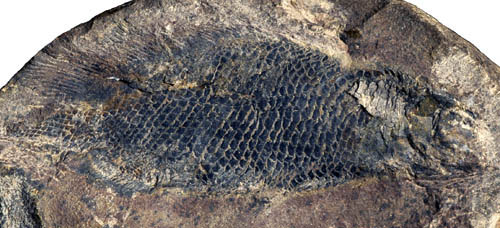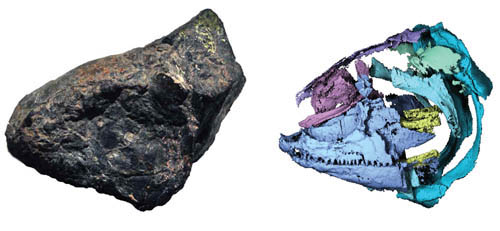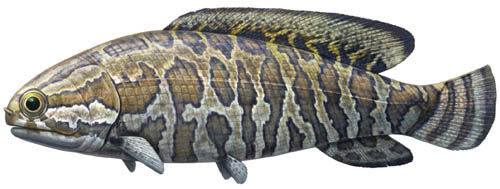On August 30, a scientific research team composed of researcher Xu Guanghui from the Institute of Vertebrate Paleontology and Paleoanthropology of the Chinese Academy of Sciences and researchers from many research institutions in the UK and the United States published a paper in the British journal Nature The latest research results on the Triassic Scanian fish order Fukang fish in Xinjiang. The scientific research team used high-resolution computed tomography technology to reveal that some anatomical features inside the skull of Fukang fish are similar to those of polyfin fish, and compared the morphological data of fossil fish with the morphological data of living ray-finned fish. The DNA sequence data of 12 nuclear genes were integrated into the cladistic analysis, and a new evolutionary tree reflecting the evolution of ray-finned fish systems was obtained. Based on the new evolutionary tree, the researchers re-estimated the molecular clock of the origin time of the crown group of ray-finned fishes and believed that the origin time of the crown group of ray-finned fishes was 20 million to 40 million years later than previously estimated. Year.
Actin-finned fishes are the most prosperous and differentiated group of living vertebrate subphylums, accounting for about half of the number of living vertebrate species. Ray-finned fishes share a common ancestor with primitive lobe-finned fishes and tetrapods (amphibians, reptiles, birds and mammals) and are of great significance in studying the early evolution and biodiversity of vertebrates. Living ray-finned fishes include polyfins, sturgeons, gars, bowfins and teleosts; among them, polyfins are considered the most primitive representatives. However, the oldest multi-finned fish fossils were only found in the early Late Cretaceous (about 100 million years ago), which is too young compared to the ray-finned fish fossil record of the Paleozoic and early Mesozoic. For a long time, almost all Paleozoic ray-finned fishes and some Mesozoic ray-finned fishes have been collectively referred to as "paleocods". Identifying and establishing the phylogenetic relationships of these early ray-finned fishes with polypterans and other ray-finned fishes has been difficult.
Xu Guanghui and his collaborators have conducted detailed studies on the "ancient cod" Scanian fishes in the past decade, and have made breakthrough progress in the elusive subject of the early evolution of ray-finned fishes. Scanias are primitive ray-finned fishes unique to the Triassic Period (approximately 252–201 million years ago). Except for one genus and species from the Late Triassic that was found in the marine strata of Sweden, the other genera and species of this order were all found in the terrestrial Triassic of Laurasia (including northern China, Siberia, Kazakhstan, and North America). Therefore, the living environment of Scanian fishes is mainly freshwater environment. The long dorsal fin Fukang fish discovered in the Middle Triassic of Fukang, Xinjiang in the 1960s represents the first discovery of Scania fish in China. In recent years, the short caudal peduncle Beishan fish discovered in the Lower Triassic of Beishan, Gansu represents one of the oldest genera and species of Scanian fishes. In addition, Zhangya Mizhi, discovered in the Upper Triassic of Mizhi, Shaanxi, represents the latest fossil record of the Scanian fish in China. Among these fossil materials, only Fukang fish has a three-dimensional preserved skull, which facilitates the use of high-resolution computed tomography technology to reveal the internal anatomical features of its skull. Thanks to the application of this new technology, researchers found that the skull of Fukang fish has some characteristics similar to those of polyfin fish, indicating that the order Scania may be the ancestral type of modern polyfin fish.
This research is a multidisciplinary application of paleontology, modern biology and molecular biology. It is also a model for the application of high-resolution computed tomography technology in the study of ray-finned fish fossils, and provides information for the study of other ray-finned fish fossils. Learned from.
The research project was funded by the National Natural Science Foundation of China. The three-dimensional scan of the fossil was completed at the High-Precision Computed Tomography (CT) Center of the Key Laboratory of Vertebrate Evolution and Human Origins, Chinese Academy of Sciences.
The links to three papers on Scanian fish research published by Xu Guanghui and his team in international academic journals in recent years are as follows:
Xu, G.-H. & Gao, K.-Q. 2011. Zoological Journal of the Linnean Society. http://onlinelibrary.wiley.com/doi/10.1111/j.1096-3642.2010.00645.x/pdf ;
Xu, G.-H., Gao, K.-Q. & Finarelli, J. A. 2014. Journal of Vertebrate Paleontology. http://www.bioone.org/doi/10.1080/02724634.2014.837053
Giles, S., Xu, G.-H., Near, T. J. & Friedman, M. 2017. Nature. http://dx.doi.org/10.1038/nature23654

Figure 1 Holotype specimen of Fukang fish with long dorsal fin (Photo provided by Xu Guanghui)

Figure 2 Three-dimensional preservation and CT identification of the long dorsal fin Fukang fish skull (Photo provided by Xu Guanghui)

Figure 3 Restored picture of the life of Fukang fish with long dorsal fin (drawn by Andrey Atuchin based on the restored base map provided by Xu Guanghui)
animal tags: fish evolution fossil sturgeon gar
We created this article in conjunction with AI technology, then made sure it was fact-checked and edited by a Animals Top editor.